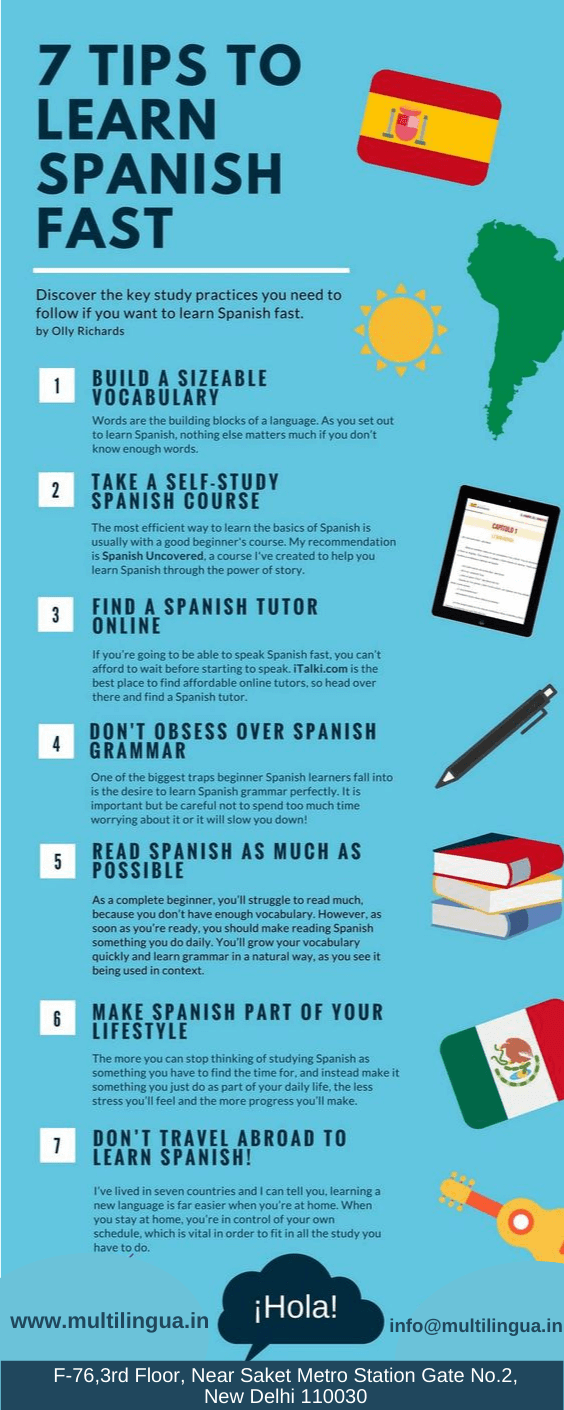
There are numerous methods for learning Spanish, and there is no one method that is superior to the others. It’s about figuring out what works for you, what aligns with your goals, and what you need to do to get there.
But, whether you go the DIY route like I did or opt for something more structured like a course, there are a few things you must keep in mind throughout your Spanish learning journey. These two factors are immersion and consistency.
By learning Spanish, you are embracing a new way of life, which necessitates immersing yourself in all things Spanish. It’s as if you need to immerse all five of your senses in the language, which you can do by moving to a Spanish-speaking country or by following the steps outlined below.
Consistency is also important. Whether you study on your own or in a class, nothing will stick if you do not practise on a regular basis. A little bit every day is far more effective than a marathon review session every weekend.
So, whatever learning methods you choose, keep in mind that consistency and immersion are the name of the game. When I’m having trouble with either of these two areas, turn to someone who will assist.
Features like authentic Spanish content and a progress tracker, has allowed me to explore the Spanish-speaking world through my phone while also keeping me on track with my daily learning goals—but I’ll explain how this worked for me later!
1. Practice grammar exercises from a textbook for an hour each day
Everybody can discover “Hugo Spanish in 3 Months,” a really simple grammar book and CD for beginners. It’s jam-packed with short explanations and exercises. All of the answers are at the back of the book, and it was a great resource for learning the fundamentals: past, present, and future tenses; prepositions; popular phrasal constructs; and explanations of plurals and gender.
I set aside an hour at the end of each day to complete the exercises. Whenever I came across a section that stumped me, I’d go back and repeat the exercises until the grammar became second nature.
It’s also worth noting that I continued to consult this grammar book for reference well into my third year in Latin America. By that point, I was really quite fluent, but minor grammatical errors would crop up here and there when I was conversing with friends.
We always advised to carry a notebook with me, make notes for myself at the moment, and then look them up in “Hugo” later that day. In fact, I still keep a notebook on my person!
2. Read, underline, look up new words, and read some more.
Reading at home was, without a doubt, the most beneficial activity I prioritized in the early stages. I read whatever I could get my hands on, but I especially enjoyed novels translated from Portuguese to Spanish by Paulo Coelho.
Why should you hire a Spanish author? Coelho’s writing is so straightforward that it is ideal for beginners. His sentences are brief and easy to comprehend. His vocabulary is also quite limited. He was the ideal choice for me.
We didn’t have a TV or internet in our Venezuelan apartment, and having lived through it, I highly recommend removing other distractions when learning a language. For about eight months, I read every evening and weekend.
3. Listen to Spanish radio
After about two years of being fairly fluent, you’ll find it enjoyable to listen to the radio in Spanish. It was difficult for me at first, but I recommend perseverance. It can be difficult to understand what someone says in a foreign language without seeing their lips.
Every day, I spent an hour and a half listening to the radio on my phone while driving to and from work in Buenos Aires.
It was a great way to speed up the journey, gave me plenty to talk about with my Argentine friends, and introduced me to some fantastic Spanish-speaking musicians. Andrés Calamaro, Vicentico, Joaqun Sabina, Anita Tijoux, Calle 13, and Gustavo Cordera, in particular.
Even after seven years in Latin America, I still hear phrases I don’t understand when I leave the radio on in the background at home. I take notes and look them up later. The process of learning to use the radio never ends.

4. Spend time in a Spanish-speaking environment
If you can’t travel abroad, go to places in your own city where Spanish-speaking people congregate. I used to go to a lot of salsa clubs before leaving London, and I remember having a great time.
I’d also eat in Spanish restaurants and drink in Spanish cocktail bars, and at one point I even joined a Spanish conversation group. It was a group formed by native Spanish speakers to bridge the cultural divide between Londoners and foreigners living far away from home.
I checked, and that particular group no longer exists, but there must be others.
Another excellent strategy is to turn your home into a Spanish learning hub! In fact, one of the most effective ways to learn Spanish is to transform your environment into one that encourages Spanish learning and education. What’s more, the best part? This is possible whether or not you live in a Spanish-speaking country!
Check out the video below for some hot tips on how to create an immersive environment. The video is from the many Spanish YouTube channels, which offers important insights into learning Spanish from native materials. Subscribe to the channel if you want to learn Spanish on your own!
5. Choose a Spanish Language Institute
When you’re learning on your own, hitting a learning plateau isn’t uncommon. That’s when you should think about getting some extra help. Getting a Spanish language institute to assist you is the ideal way to restart your language learning progress, especially if you are not exposed to Spanish on a regular basis, as you want to learn in a live classroom session.
Depending on where you live, you may have limited access to a native Spanish language institute, even if only for a short period of time. Fortunately, there are many online coaching institutes available.
Multilingua provides the best quality of Spanish language classes with qualified language teachers. Our lessons include training materials, and scheduling is designed to be flexible so that you can book a session that works for you. Tha classroomt feature is fantastic—who wants to be bound by someone else’s schedule? Language learning on your own time will work around your schedule!
6. Translate as frequently as possible
Understanding and conversing with native speakers is only one aspect of learning Spanish. You must also be able to think in the language, which means translating in your head whenever possible.
When I’m in the presence of Spanish road signs and locals, my brain will try to translate everything I see and hear into English. That is precisely what you must strive for.
If you can’t be in a Spanish-speaking environment, translate everything you read into Spanish, whether it’s a social media post or a restaurant menu. Once you’ve established this practice, your mind will want to translate everything you see into Spanish.
You are not required to write these translations down every time, but you are welcome to do so! This trick is mostly intended to encourage you to think in Spanish throughout the day rather than restricting your learning to set study times.
Because there was so much new information to process, you did it out of habit at first. Type out the translation on your phone whenever you are out and about and see new signs and instructions.
7. Try Talk to yourself in Spanish
Unless you relocate to a Spanish-speaking country, you will not always have many opportunities to converse in Spanish. You’ll need all the practice you can get so that when there’s no one around to talk to, you can (and should) talk to yourself.
We all talk to ourselves on a regular basis. I can’t tell you how many times I’ve left my house wondering if I’d unplugged my curling iron and locked the front door. You might as well do the same thing in Spanish if you’re anything like others. If you want to do it in advance, you can boost your confidence by talking to yourself in the mirror.
Final words about learn Spanish Language
By learning Spanish, you are embracing a new way of life, which necessitates immersing yourself in all things Spanish. It’s as if you need to immerse all five of your senses in the language, which you can do by moving to a Spanish-speaking country.
Consistency is also important. Whether you study on your own or in a class, nothing will stick if you do not practise on a regular basis. A little bit every day is far more effective than a marathon review session every weekend.
So, whatever learning methods you choose, keep in mind that consistency and immersion are the name of the game.
